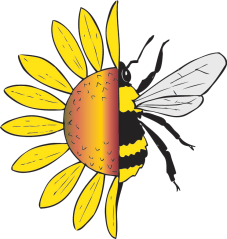Spring is a marvelous time to explore an old apple orchard. Walking under the white blossomed branches it is reassuring to know that the flowers are abuzz with busy pollinators, ensuring a bountiful fall harvest of sumptous red fruit. Peach Hill Park is one such abandoned apple orchard in the Town of Poughkeepsie, containing 10,000 trees. The park encompasses 159 acres and is also is the highest point in the Town at 485 feet containing impressive views of the Catskills, Shawangunks and the Hudson Highlands.
The last year it was actively farmed was in 1998. When the property was put on the market, a group of concerned citizens working with Scenic Hudson and the Town of Poughkeepsie began an initiative to preserve this unique open space against the pressure of development. The name Peach Hill takes it name from the original peach orchard that was converted to an apple orchard over the ensuing years.
Early spring bees are important pollinators of apple trees and Peach Hill Park makes an ideal location to see these bees at work. With so many trees in blossom all at once, it is a rush of pollen and nectar. In many monocultures, this could mean feast and famine to many native bees who only have a flight range from a quarter mile to a mile in radius. However, this abandoned apple orchard affords a diversity of flowering plants from early blooming bloodroot and trout lilies along the forest edge to goldenrod and asters that have established themselves throughout the orchard; providing a constant food source to pollinators all season long.
If you are out enjoying the spring blossoms of Peach Hill Park, or any old orchard, keep an eye out for spring pollinators such as mining bees (Andrena spp.), represented by 99 species in New York State. Contrary to our image of bees, mining bees like most bees, are not aggressive. These efficient and abundant pollinators are solitary bees and have no queen and no hive to protect. Every female bee lays her own eggs in an underground chamber often in association with other bees.
Peach Hill Park contains a large aggregation of these bees that are active in the early spring around the time the pussy willow blooms and just before the apple trees blossom. These nesting areas often go unnoticed as their holes are mistaken for ant hills and the period of active nesting is only for a brief time. Once the eggs are laid in the underground chambers, they hatch and the larvae feast on the “bee bread” left by their mother. The young mature and metamorphisis over the course of the summer, lay dormant underground during the winter and emerge the following spring.
During the apple blossom season you will encounter overwintering queen bumblebees (bombus spp.). Unlike, most other native bees, bumblebees are social and will establish a colony consisting of 50-200 workers that will assist with raising the subsequent generations of brood. In addition to pollinating, it is fun to watch the queen as she explores potential cavities in search of a suitable home. The first workers will usually begin emerging after the apple blooms are long gone.
There are many other spring bees including the tiny metallic green sweat bee (augochlora app.), the fast moving blue orchard bees (osmia spp.), the large carpenter bees and the non-native honeybee.
Apple blossom season is short and the gentlest of breezes cause the white petals fall to the ground like spring snow. The quick and efficient work of our native bees is complete, while some bees move on to other flowers, the spring mining bees disappear as quickly as the apple blossoms.
Categories: ground nesting bees, Mining bees, native bees, pollen bees, Uncategorized










